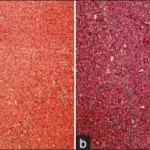Rickets is a condition characterized by a defect in mineralization of the epiphyseal plates.
What is the Pathology of Rickets?
The pathology of rickets is:
-Etiology: The cause of rickets is vitamin D deficiency.
-Genes involved: PHEX, FGF-23, and VDR.
-Pathogenesis: The sequence of events that lead to rickets involves decreased availability of phosphorus and calcium to mineralize the skeletal matrix, leading to growth plate disorganization and accumulation of under mineralized osteoid.
-Histology: The histology associated with rickets shows thickened, poorly defined growth plates, particularly on the metaphyseal side, tongues of uncalcified cartilage may extend into metaphysis, wide osteoid seams.
How does Rickets Present?
Patients with rickets typically affect males and females present at the age range of 2 and above. The symptoms, features, and clinical findings associated with rickets include bone tenderness, bowed legs or knock knees, thickened wrists and ankles, and breastbone projection.
How is Rickets Diagnosed?
Rickets is diagnosed by blood tests showing serum calcium, serum phosphorous, and serum alkaline phosphatase levels, bone density scan, or radiography.
How is Rickets Treated?
Rickets is treated by use of vitamin D along with exposure to sunlight.
What is the Prognosis of Rickets?
The prognosis of rickets is generally good. However, a complete recovery can take some time.

